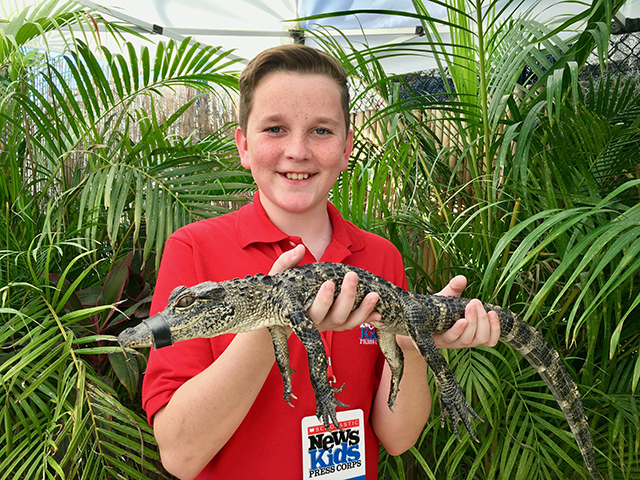KID REPORTERS’ NOTEBOOK
A Visit to the Everglades


Ryan holds an alligator at Everglades Holiday Park in Fort Lauderdale, Florida.
The Florida Everglades is home to more than 70 threatened or endangered species. People sometimes describe the Everglades as a swamp. It is actually the largest subtropical ecosystem in North America.
I recently took an airboat ride through Everglades Holiday Park in Fort Lauderdale, Florida, to learn more about the Everglades and the animals that find refuge there.
The 1.5-million-acre wetlands preserve stretches across the southern tip of Florida, from the Kissimmee River to Lake Okeechobee.
“The Everglades is actually the shallowest and slowest moving river in North America,” said Dylan Martin, a senior boat captain. “Its nickname is the ‘endless river of grass.’”
Hundreds of animal species can be found in the Everglades, including raccoons, skunks, bobcats, and white-tailed deer. The Everglades is also home to exotic birds, snakes, and reptiles. The ecosystem has one of the world’s largest populations of vultures and more than 200 different types of fish.

Ryan at Everglades Holiday Park with animal behavioralist Paul Bedard
THE AMERICAN ALLIGATOR
The most well-known resident of the Everglades is the American alligator. In fact, the largest population of American alligators in the world can be found in the Everglades, which is home to more than 200,000 gators. (The Chinese alligator, which is smaller, is the only other alligator species still in existence.)
Decades ago, hunting decimated the population of American alligators. In 1973, the animal was listed as an endangered species.
“There’s a very big demand for alligator skin, meat, and teeth,” Martin explained. “People were killing alligators just to make a profit.”
Today, the American alligator is making a strong comeback. Martin attributes that to stricter hunting laws.
“Now, the hunting season is controlled to just two months a year, which has really helped,” Martin said. In 1986, the animal was removed from the endangered species list.
A MESSAGE OF CONSERVATION
Paul Bedard, an animal behavioralist, helps to relocate alligators to Everglades Holiday Park. “When an alligator finds its way into a residential area, it’s referred to as a ‘nuisance alligator,’” Bedard explained. “That’s when people call trappers like me to have it removed.”
In Florida, licensed trappers don’t charge a fee for taking away nuisance alligators. But they don’t have many choices about what to do with them.
“Alligators that are trapped and measure over 4 feet long must, by law, be destroyed or go into captivity,” Bedard said. That results in about 7,000 nuisance alligators being killed each year.
Bedard wants to protect American alligators. He deliver the ones that he rescues to the sanctuary at Everglades Holiday Park, where he educates crowds during a live Gator Show almost every day. The program features some of the nearly 100 gators that he has helped to save.
Bedard also takes his conservation message to larger audiences. He is one of the stars of Gator Boys Alligator Rescue, a hit TV show on Animal Planet.
“The alligator population has been pretty constant for the last couple of years,” Bedard said. “We’re at a good balance right now.”
But the animal expert cautioned that construction could upset the balance. “We need to stop building into the alligators’ environment,” he added.
Martin agreed. “Every piece of land is valuable,” he said. “The more we take care of it, the more it will take care of us and each living thing that depends on it.”
